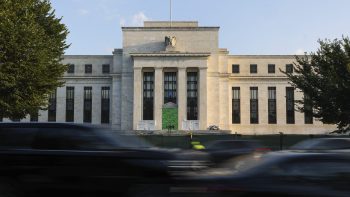Where does all that Fed money go?
TEXT OF STORY
Kai Ryssdal: Analysts at Goldman Sachs said today there’s still plenty of squeeze left in the credit squeeze. They figure total losses worldwide are going to hit $1.2 trillion. Wall Street’s going to account for about a third of that.
The Federal Reserves been doing what it can to help, besides bailing out Bear Stearns, I mean. One of the ways Bernanke and company have been trying to prop things up is by literally putting more money into the market. Not with printing presses, but by short-term auctions to keep the lending pump primed.
Commercial banks can bid for month-long loans from the central bank at pretty good interest rates. Today, the Fed announced the results of its latest auction — the eighth — for a total of $260 billion since December.
What happens to all that money? We’re glad you asked.
John Dimsdale reports from Washington.
John Dimsdale: On the block this time was $50 billion, which banks will borrow at a low 2.6 percent interest rate for 28 days.
The auctions are designed to provide banks with reserves used to cover everyday operations such as cash withdrawals from checking and savings deposits as well as individual or corporate loans. Since the auction money must be returned to the Fed in four weeks, it’s generally not used to backstop long-term borrowing, like mortgages.
Brian Bethune is an economist with Global Insight. He says normally when banks run low on short-term reserves, they have to borrow from each other.
Brian Bethune: If a bank avails itself of those options, there can be sense of maybe that bank has some problems in terms of funding itself, so what the Fed said is in order to avoid that problem, we’ll create this temporary auction facility so banks can borrow those funds and borrow those funds anonymously.
Even after $260 billion in short term low-interest loans, banks remain reluctant to lend. John Dearie is with the industry trade association, the Financial Services Forum. He says so far the Fed auctions are helping banks with their day-to-day operations. Soon, he thinks the money will help them overcome their lending skittishness.
John Dearie: I think the evidence is that it is working. It’s going to take time. These are not problems that will be solved overnight.
The Fed reports plenty of demand for its low-interest loans. With $50 billion to auction, the central bank received bids for $90 billion.
In Washington, I’m John Dimsdale for Marketplace.
There’s a lot happening in the world. Through it all, Marketplace is here for you.
You rely on Marketplace to break down the world’s events and tell you how it affects you in a fact-based, approachable way. We rely on your financial support to keep making that possible.
Your donation today powers the independent journalism that you rely on. For just $5/month, you can help sustain Marketplace so we can keep reporting on the things that matter to you.


















